INTERMOLECULAR FORCES
In answering question of IMF, make sure understand about POLARITY OF THE MOLECULES- if the molecules is
a) NON POLAR , thus its IMF is LONDON DISPERSION FORCES
b) POLAR , thus its IMF is DIPOLE-DIPOLE FORCES or HYDROGEN BOND
1. What type of intermolecular forces are due to the attraction between temporary dipoles and their induced temporary dipoles?
* If this kind of question, please understand the definition of each type of INTERMOLECULAR FORCES.
Keypoints: attraction between temporary dipoles and their induced temporary dipoles
ANSWER:
LONDON DISPERSION FORCES
⇰because LONDON DISPERSION FORCES is a force
of attraction between *instantaneous(temporary) dipole* that arise from a short time scale fluctuation in the electronic
structure of species when they become very close to one another (induced temporary dipoles).
2. What type of interparticle forces holds liquid N2 together?
* INTERPARTICLE = INTERMOLECULAR
BUT Interparticle always used when involves simple molecules
Liquid N2 is NONPOLAR
ANSWER:
N2 has LONDON DISPERSION FORCES
3. Which of the following will have hydrogen bonding?
H3CCH2CH2OH CH3CH2OCH3 CH3CH2NH2 CH3CH2SH
STRUCTURE 1 : Molecules have Hydrogen bond between its molecules
STRUCTURE 2 : Molecules have Hydrogen bond between its molecules
STRUCTURE 3 : Molecules do not have Hydrogen bond between its molecules
STRUCTURE 4 : Molecules do not have Hydrogen bond between its molecules
ANSWER: H3CCH2CH2OH and CH3CH2NH2
4. Which of the molecules has higher boiling point, CH3CH2OH or CH3OCH3 ?
Both molecules have molecular weight = 46g/mol
But they have difference intermolecular forces among its own molecules.
CH3CH2OH has hydrogen bond between its molecules but CH3OCH3 has dipole-dipole forces between its molecules
Thus, CH3CH2OH has higher boiling point than CH3OCH3
ANSWER: CH3CH2OH
METALLIC BOND
1. Describe the structure of a metal.
Explanation on the structure in ELECTRON SEA MODEL
ANSWER:
Giant structure of atoms arranged in an array pattern
2. Describe the position of electrons in a metal.
Explanation must highlight on the DELOCALIZED OF ELECTRONS
ANSWER:
The electron delocalized around the metal ion
3. Draw a diagram to represent a metal, representing the electrons and the respective charges.
Explanation based on the structure in ELECTRON SEA MODEL. Give any example of metal element
ANSWER:
4. What are the structural differences between a pure metal and an alloy? ANSWER:
A pure metal contains atoms of the same metal whereas an alloy is compiled of different metal atoms.
In pure metals, the atoms are arranged in layers / alloys have distorted layers.
5. Fill in the box with correct answer
ANSWER:
*This post just to share the idea on variety of questions in the IMF & Metallic bond.
Please give some comment on roughly idea of IMF & Metallic Bond in the COMMENT POST as I can know your presence in reading this post. TQ.



















































